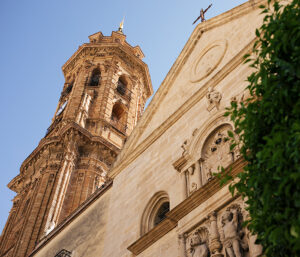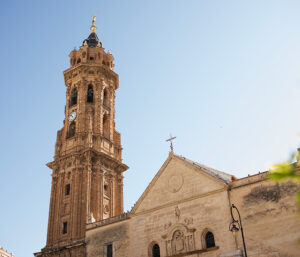The primitive style of the Collegiate Church is that of a still undecided Renaissance. On its façade the most interesting thing is its beautiful Renaissance façade. It has three bodies. The lower one is framed by pairs of fluted shaft columns and capitals of Corinthian shape and somewhat fantastic composition. The spandrels of the access arch are decorated with two clypeos that enclose busts of Santiago and San Felipe. The second body has balusters and shallow venerated niches that occupy sculptures of San Pedro, San Pablo and San Sebastián. In the attic are the arms of Emperor Charles V inserted in the double-headed eagle. It is interesting to observe the Hercules child and the representations of Twilight and Night, which were placed in the air, perhaps by a failure of the stonemasons.

Very interesting is the tower, begun to raise in the first body of ashlar masonry by Ignacio de Urzueta and continued from 1701 by the Antequera master builder Andrés Burgueño. Later, in 1722, Nicolás Mejías replaced the original spire with another that was destroyed in 1926 because of a fire. Two years later the current spire was made. The element that has remained despite the transformations is the Angelshark, the name by which the guardian angel who crowns the tower and serves as a weather vane is popularly known. This terrestrial lighthouse presents a complex architectural structure in the brick bodies, as well as its general decoration based on applications of blows of baked clay, modeled, carved and distributed with success and elegance.
The interior of San Sebastián has three naves separated by cruciform pillars and attached Ionic half-columns. On these pillars rest semicircular arches. The naves were covered with wooden armor, today hidden with plaster vaults. We know nothing about what the main chapel could have been like, since an explosion totally destroyed it. In the center of the nave we find the choir, with interesting masonry carved in wood, from the disentailed convent of San Agustín, and two baroque style organs. On the steps of the presbytery is located the tabernacle of gilded wood, which was made for the main chapel of Santa María, temple from which it was brought when the Collegiate Church was moved.

As for the altarpiece, it is worth mentioning that of Santa María de la Esperanza, which occupies the front of the nave of the gospel, the work of Bernardo Simón de Pineda. The images of San Sebastián and Santa María de la Esperanza are prior to this altarpiece, Gothic sculpture of the early fifteenth century, although its stew and cloths were renewed in the late seventeenth century. In the front of the nave of the epistle is the altarpiece of the Virgin of Antigua, Renaissance image, which comes from the Collegiate Church of Santa María, very elegant in composition and perfect modeling.
In the nave of the Gospel, next to the door of the sacristy, is the tomb of Rodrigo de Nárvaez, first warden of the city. In the nave of the Epistle it is worth mentioning a Dolorosa de vestir of the late eighteenth century, possibly by Miguel Márquez García. At the entrance to the wall of the choir we find a bulky neo-Gothic altarpiece of the late nineteenth century. Its ornaments are occupied by three works by Andrés de Carvajal, In the center the Christ of the Greater Pain, a masterpiece of the artist, which represents Jesus after the scourging, kneeling and collecting his tunic. Much of the ancient and rich treasure of the Collegiate Church was transferred to this church and is currently exhibited in the Museum of the City.
Contact:
Address: Plaza San Sebastian, 6, Antequera, Malaga.
Phone: 952 84 11 58
